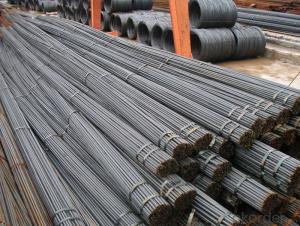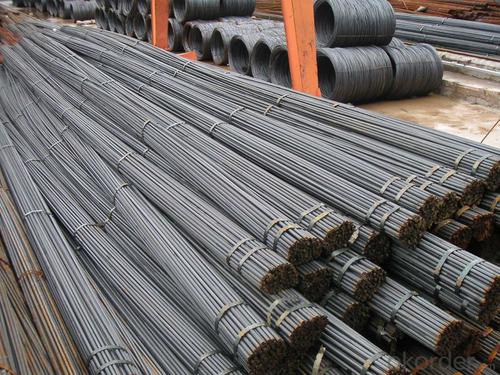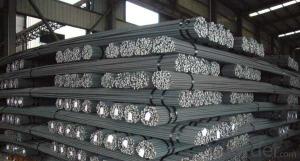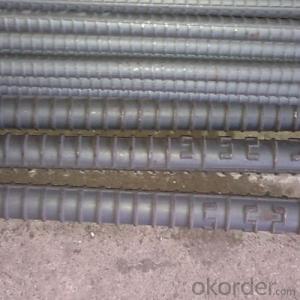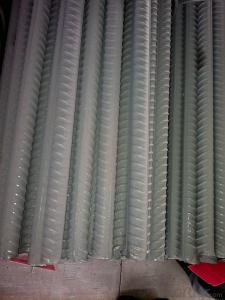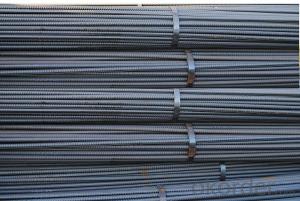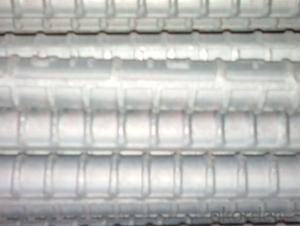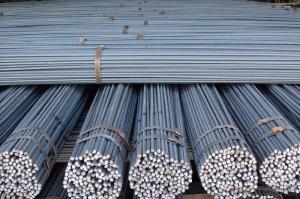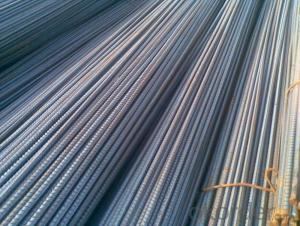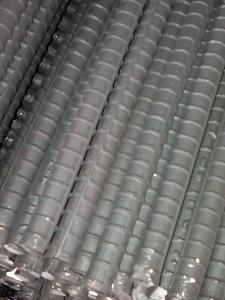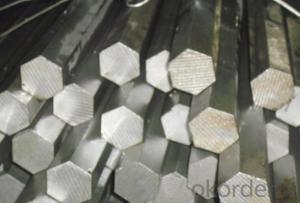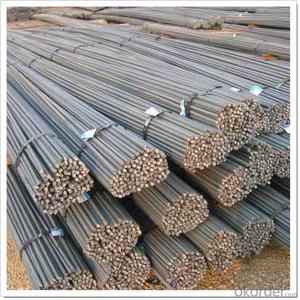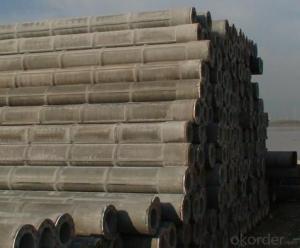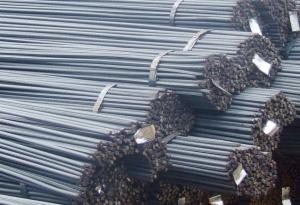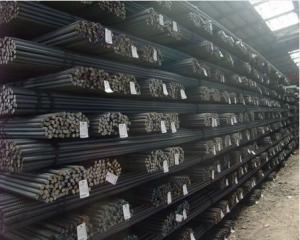Hot Rolled Carbon Steel Deformed Bar 14mm with High Quality
- Loading Port:
- China Main Port
- Payment Terms:
- TT or LC
- Min Order Qty:
- 25 m.t.
- Supply Capability:
- 20000 m.t./month
OKorder Service Pledge
OKorder Financial Service
You Might Also Like
Product Description:
OKorder is offering Hot Rolled Carbon Steel Deformed Bar 14mm with High Quality at great prices with worldwide shipping. Our supplier is a world-class manufacturer of steel, with our products utilized the world over. OKorder annually supplies products to European, North American and Asian markets. We provide quotations within 24 hours of receiving an inquiry and guarantee competitive prices.
Product Applications:
Hot Rolled Carbon Steel Deformed Bar 14mm with High Quality is widely used in buildings, bridges, roads and other engineering construction. Big to highways, railways, bridges, culverts, tunnels, public facilities such as flood control, dam, small to housing construction, beam, column, wall and the foundation of the plate, deformed bar is an integral structure material. With the development of world economy and the vigorous development of infrastructure construction, real estate, the demand for deformed bar will be larger and larger..
Product Advantages:
OKorder's Hot Rolled Carbon Steel Deformed Bar 14mm with High Quality are durable, strong.packed and suitable for construction
Main Product Features:
· Premium quality
· Prompt delivery & seaworthy packing (30 days after receiving deposit)
· Can be recycled and reused
· Mill test certification
· Professional Service
· Competitive pricing
Product Specifications:
Manufacture: Hot rolled
Grade: HRB335 HRB400 BS4449 Grade460 ASTM Grade40 Grade60
Certificates: ISO, SGS, BV, CIQ
Length:6m 8m 9m 12m
Packaging: Export packing, packed by coil
FAQ:
Q1: Why buy Materials & Equipment from OKorder.com?
A1: All products offered byOKorder.com are carefully selected from China's most reliable manufacturing enterprises. Through its ISO certifications, OKorder.com adheres to the highest standards and a commitment to supply chain safety and customer satisfaction.
Q2: How do we guarantee the quality of our products?
A2: We have established an advanced quality management system which conducts strict quality tests at every step, from raw materials to the final product. At the same time, we provide extensive follow-up service assurances as required.
Q3: How soon can we receive the product after purchase?
A3: Within three days of placing an order, we will begin production. The specific shipping date is dependent upon international and government factors, but is typically 7 to 10 workdays.
Q4: How many tons per bundle?
A4: Around 2-3tons
Q5: How to avoid the rust after deliver the goods to the loading port?
A5: We will keep the goods at the port covered with water-proof material
Q6: What is the chemical composition and physical properties of HRB400?
A6
Grade | Technical data of the original chemical composition (%) | ||||||
C | Mn | Si | S | P | V | ||
HRB400 | ≤0.25 | ≤1.60 | ≤0.80 | ≤0.045 | ≤0.045 | 0.04-0.12 | |
Physical capability | |||||||
Yield Strength (N/cm²) | Tensile Strength (N/cm²) | Elongation (%) | |||||
≥400 | ≥570 | ≥14 | |||||
Q7:What is chemical composition and physical properties of 500B?
A7:
BS4449 500B | Chemical Composition | ||||
C | Mn | Si | S | P | |
0.24 | 0.45 | 0.16 | 0.05 | 0.31 | |
Physical capability | |||||
Yield Strength(N/cm²) | Tensile Strength(N/cm²) | Elongation (%) | |||
650 | ≥500 | 19 | |||
Images:
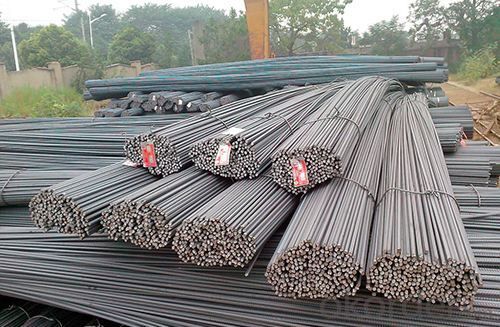
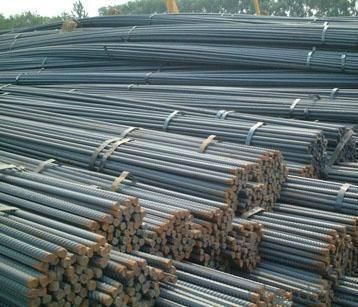
- Q: How do steel rebars improve the durability of concrete structures?
- Steel rebars improve the durability of concrete structures in several ways. Firstly, steel rebars act as reinforcement in concrete, providing added strength and stability to the structure. When combined with concrete, the high tensile strength of steel rebars helps to resist cracking and prevent the structure from collapsing under heavy loads or seismic activities. Secondly, steel rebars help to control the formation and propagation of cracks in concrete structures. Concrete is strong in compression but weak in tension, meaning it tends to crack when subjected to tensile forces. By placing steel rebars strategically within the concrete, these cracks are minimized and prevented from spreading, thus enhancing the overall durability of the structure. Furthermore, steel rebars help to improve the resistance of concrete structures against corrosion. Concrete is highly alkaline, which forms a protective layer around the steel rebars, preventing them from rusting. This corrosion resistance ensures that the rebars maintain their structural integrity over time, reducing the risk of deterioration and enhancing the longevity of the concrete structure. In addition, steel rebars also enhance the fire resistance of concrete structures. Due to their high melting point, steel rebars can withstand high temperatures, thereby preventing the concrete from losing its structural integrity during a fire. This added fire resistance ensures that the concrete structure remains stable and safe in the event of a fire, further enhancing its durability. Overall, the inclusion of steel rebars in concrete structures significantly improves their durability by providing added strength, controlling cracks, enhancing corrosion resistance, and increasing fire resistance. These benefits contribute to the longevity and safety of concrete structures, making them more reliable and sustainable in the long run.
- Q: What is the difference between carbon steel and stainless steel rebars?
- Carbon steel and stainless steel rebars are both types of steel reinforcement used in construction, but they have distinct differences in composition and properties. Carbon steel rebars are made from a combination of iron and carbon, with small amounts of other elements such as manganese and copper. The carbon content in these rebars typically ranges from 0.15% to 0.60%. Carbon steel rebars are strong, durable, and cost-effective. They have good tensile strength, which is crucial for reinforcing concrete structures. However, they are susceptible to corrosion if not properly protected, especially in environments with high moisture or exposure to chemicals. On the other hand, stainless steel rebars are made from a combination of iron, chromium, nickel, and other alloying elements. The chromium content in stainless steel is typically above 10.5%, which creates a protective layer of chromium oxide on the surface of the rebar, preventing corrosion. Stainless steel rebars have excellent corrosion resistance, even in harsh environments with high humidity, saltwater, or exposure to chemicals. They are also highly durable and have high tensile strength, similar to carbon steel rebars. The main difference between carbon steel and stainless steel rebars is their corrosion resistance. Carbon steel rebars require proper protective coatings, such as epoxy or galvanization, to prevent corrosion. On the other hand, stainless steel rebars have inherent corrosion resistance due to the presence of chromium oxide layer, eliminating the need for additional coatings. Another difference is the cost. Carbon steel rebars are generally cheaper compared to stainless steel rebars. However, the total cost of a project should also consider the long-term maintenance costs associated with corrosion protection measures required for carbon steel rebars. In summary, carbon steel rebars are strong and cost-effective but require additional corrosion protection measures, while stainless steel rebars have excellent corrosion resistance and durability but come at a higher cost. The choice between the two depends on the specific project requirements, budget, and expected environmental conditions.
- Q: How do steel rebars prevent corrosion in concrete structures?
- Steel rebars prevent corrosion in concrete structures through a process called passivation. When rebars are embedded in concrete, the alkaline environment of the concrete causes the formation of a protective oxide layer on the surface of the steel. This oxide layer acts as a barrier, preventing the penetration of oxygen and moisture that are necessary for corrosion to occur. Additionally, rebars are often coated with epoxy or galvanized to provide an extra layer of protection against corrosion.
- Q: How do steel rebars improve the flexural strength of concrete?
- Steel rebars improve the flexural strength of concrete by providing reinforcement and resisting tensile forces. Concrete is a strong material in compression but relatively weak in tension. When subjected to bending or other flexural stresses, concrete tends to crack and fail due to its limited tensile strength. By adding steel rebars to the concrete, the composite material gains enhanced flexural strength. The rebars act as a reinforcement by absorbing the tensile forces and distributing them throughout the structure. When the concrete is subjected to bending, the rebars resist the tension, preventing the formation and propagation of cracks. The rebars are typically placed in areas where tensile stresses are expected, such as the bottom of a beam or the tension face of a slab. They are designed to provide sufficient strength to carry the tensile forces and prevent the concrete from failing. The bond between the rebars and the concrete is crucial to ensure effective load transfer from the concrete to the steel reinforcement. Additionally, the use of rebars allows for the design of thinner and more efficient concrete elements. By providing the necessary tensile strength, the amount of concrete required can be reduced, resulting in cost savings and lighter structures. The combination of concrete and steel rebars maximizes the material properties of both components, creating a composite material that is strong in both compression and tension. Overall, steel rebars improve the flexural strength of concrete by reinforcing it against tensile forces, preventing cracking and failure. This reinforcement allows for the design of more efficient and durable structures.
- Q: How do steel rebars impact the constructability and formwork requirements of concrete elements?
- Steel rebars have a significant impact on the constructability and formwork requirements of concrete elements. The presence of rebars adds strength and durability to the concrete structure, allowing for the construction of larger and more complex elements. However, the inclusion of rebars also necessitates careful planning and coordination during the formwork process. The formwork needs to be designed and installed in a way that accommodates the positioning and alignment of rebars, ensuring proper reinforcement and optimal structural integrity. Additionally, rebars can increase the weight and size of the concrete elements, affecting the logistics and handling during construction. Overall, steel rebars are essential for reinforcing concrete elements but require careful consideration and adaptation in terms of constructability and formwork requirements.
- Q: Can steel rebars be used in seawater desalination plants?
- Yes, steel rebars can be used in seawater desalination plants, but it is important to consider the corrosion potential of steel in a saline environment. Proper corrosion protection measures, such as using corrosion-resistant coatings or stainless steel rebars, should be implemented to ensure the longevity and structural integrity of the plant.
- Q: Are there any environmental concerns associated with steel rebar production?
- Yes, there are environmental concerns associated with steel rebar production. The production process involves the extraction of raw materials, such as iron ore, which has a significant impact on land and water resources. Additionally, the production of steel rebar requires a substantial amount of energy, which often comes from non-renewable sources, leading to greenhouse gas emissions. Moreover, the manufacturing process generates waste materials and pollutants, such as slag and emissions from furnaces. To mitigate these concerns, efforts are being made to improve energy efficiency, reduce emissions, and promote recycling in the steel rebar industry.
- Q: What are the different types of steel rebars available in the market?
- There are several types of steel rebars available in the market, including conventional carbon steel rebars, epoxy-coated rebars, galvanized rebars, stainless steel rebars, and high-strength rebars. Each type has specific properties and advantages depending on the intended application.
- Q: Can steel rebars be used in heritage bridge restoration?
- Yes, steel rebars can be used in heritage bridge restoration. Steel rebars provide added strength and structural integrity to the bridge, ensuring its long-term stability and durability.
- Q: How are steel rebars used in flat slabs and beams?
- Steel rebars are used in flat slabs and beams to provide reinforcement and increase the structural strength of the concrete. They are placed strategically within the slabs and beams to resist tensile forces and prevent cracking or failure under heavy loads. The rebars act as a framework that enhances the overall durability and load-carrying capacity of the flat slabs and beams, ensuring their stability and longevity.
Send your message to us
Hot Rolled Carbon Steel Deformed Bar 14mm with High Quality
- Loading Port:
- China Main Port
- Payment Terms:
- TT or LC
- Min Order Qty:
- 25 m.t.
- Supply Capability:
- 20000 m.t./month
OKorder Service Pledge
OKorder Financial Service
Similar products
Hot products
Hot Searches
Related keywords
